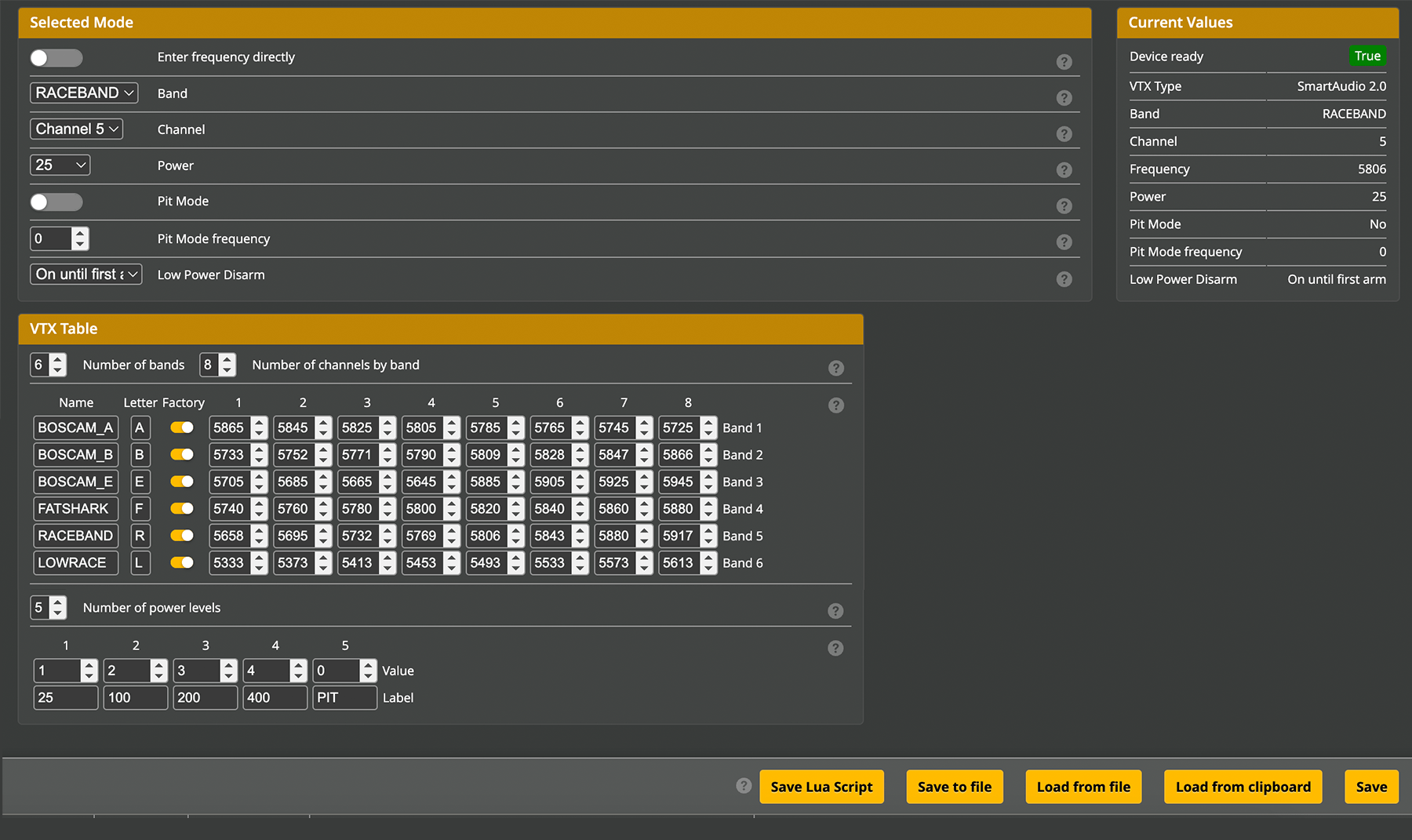Video Transmitter Tab
Configure the video transmitter (VTX) using this tab. It allows setting of the power, band, channels, etc.
note
When using a DJI or Walksnail video transmitters, this tab can be ignored. This is only used for analog and HDZero video transmitters.

It is important to have VTX Telemetry (SmartAudio or Tramp) enabled in the Ports tab to use this feature.
Selected Mode
| Option | Description |
|---|---|
| Enter frequency directly | When enabled, the Configurator will send a frequency value in place of the habitual band/channel. For this to work the VTX must support this feature. |
| Band | Select the band to use. |
| Channel | Select the channel to use. |
| Power | Select the power level to use. |
| Pit Mode | When enabled, the VTX enters in a very low power mode to let the quad be on at the bench without disturbing other pilots. Usually the range of this mode is less than 5m. NOTE: Some protocols, like SmartAudio, can't enable Pit Mode via software after power-up. |
| Pit Mode frequency | Select the frequency to use in Pit Mode. |
| Low Power Disarm | When enabled, the VTX uses the lowest available power when disarmed (except if a failsafe has occurred). |
Current Values
| Option | Description |
|---|---|
| Device ready | Indicates if the Flight Controller is talking to the VTX. |
| VTX Type | The type of telemetry that is used to communicate with the VTX. |
| Band | The current band that the VTX is set to. |
| Channel | The current channel that the VTX is set to. |
| Frequency | The current frequency that the VTX is set to. |
| Power | The current power level that the VTX is set to. |
| Pit Mode | Indicates if the VTX is in Pit Mode. |
| Pit Mode frequency | The frequency that the VTX is set to when in Pit Mode. |
| Low Power Disarm | Indicates if the VTX is in Low Power Disarm mode. |
VTX Table
| Option | Description |
|---|---|
| Number of bands | The number of bands that the VTX supports. |
| Number of channels by band | The number of channels that the VTX supports. |
| Name, Letter, Frequencies | This table represents all the frequencies that can be used for the craft's VTX. It's possible to have several bands and for each band it is required to configure:BOSCAM_A, FATSHARK or RACEBAND. |
| Number of power levels | The number of power levels that the VTX supports. |
| Power levels | This table represents the different values of power that can be used for the VTX. They are divided into two: |
Bottom Bar
| Option | Description |
|---|---|
| Save | Save the changes to the Flight Controller |
| Save to file | Save the VTX settings to a JSON File |
| Load from file | Load the VTX settings from a JSON File |
| Load from clipboard | Load the VTX settings from the clipboard. Has to be a valid JSON. |
| Save Lua Script | The 'Save Lua Script' button will allow to save a mcuid.lua file containing the VTX table configuration that can be used with the Betaflight TX Lua Scripts. Version 1.6.0 and above can use the file as is, but for older versions of the scripts it should be renamed to match the model name on the TX. |
For more information about:
- VTx Tables, see this Wiki document.
- VTx CLI commands, see this Wiki document.